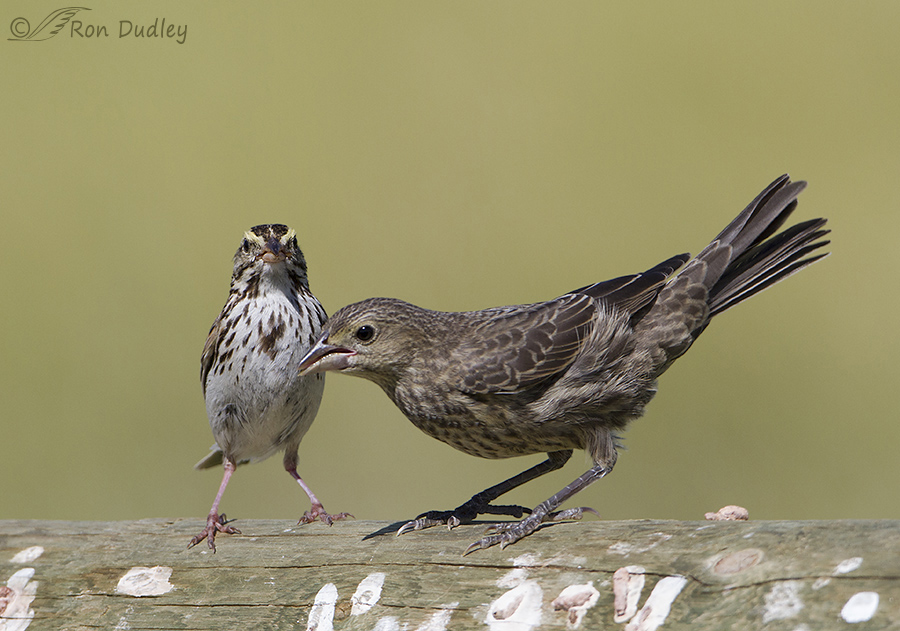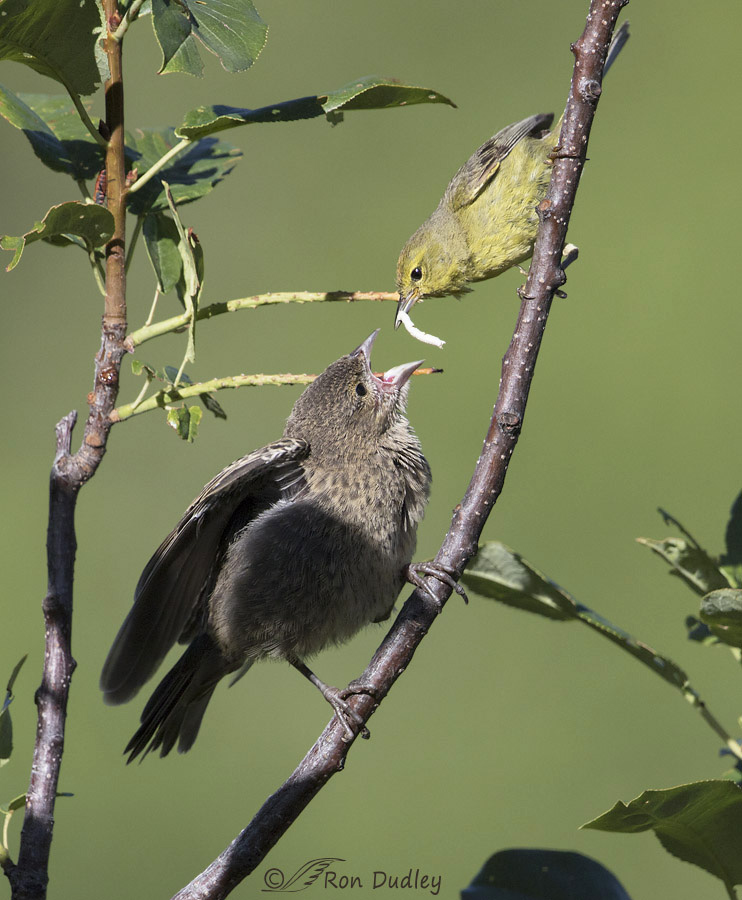The difference in size isn’t always this extreme but it can be even more dramatic than some of the examples I’ve included here.
Brown-headed Cowbirds are North America’s best known brood parasites, meaning they lay their eggs in the nests of other species which essentially forces the host species to raise their young for them. My readers and I have discussed the process and results of brood parasitism in previous posts but today’s edition of Feathered Photography will focus on the visual size difference between the young cowbirds and their “adoptive parent” species.

The adult Savannah Sparrow on the left had just stuffed a large insect into the bill of the fledgling cowbird on the right. The cowbird is in the process of swallowing it as the sparrow waits to feed it another smaller insect that isn’t easily seen in its bill. I have other photos that show the actual food transfer but with this side view of the cowbird we get a better feel for the difference in size between parasite and host.
It’s one thing to read that the average weight of the two species as adults is 20 grams vs 44 grams but to actually see that difference in size really drives it home. Imagine the number of insects the relatively small “parent” sparrows would have to deliver in order to raise a youngster of this size. It exhausts me just to think about it.
But in the case of some other host species the task would be even more daunting.

This Orange-crowned Warbler host is delivering an insect to the fledgling cowbird it’s raising. Adult Orange-crowned Warblers average only 9 grams in weight so the cowbird it is raising will be nearly 5 times heavier (larger) as an adult than its adoptive parent.
The size difference between parasite and host isn’t always this dramatic. Over 220 host species have been reported as parasitized by cowbirds, ranging in size up to 150 gram meadowlarks.
I know from previous blog posts on this subject that many of my readers dislike cowbirds because of their parasitic habits but personally I lean in another direction. Their parasitic ways evolved naturally and then their range expanded because of the effects of humans on the landscape. I have no problem with natural behaviors and we can only blame ourselves for causing cowbirds to expand their range and find many new host species they didn’t naturally coevolve with.
Most of any “blame” rests squarely on our shoulders.
Ron


Parenting looks overwhelming to me at the best of times. I suspect that in terms of ‘need’ many parents forget about the size differentials.
Parasites? Rightly or wrongly I count us as right up there with the best of them.
Thanks for yet another fascinating start to my day.
“Parasites? Rightly or wrongly I count us as right up there with the best of them.”
Or the worst of them, depending on how you look at it. Well said, EC.
Truly remarkable Ron. Great educational series and the photos are excellent. I was not aware that this was something certain birds did until one of your previous posts. Maybe if I had been in your biology class I would have been more interested.
Everett Sanborn, Prescott AZ
Don’t feel like the Lone Ranger, Everett. Lots of folks don’t know about brood parasitism. Thanks.
Brood parasites are fascinating subjects to study. They are certainly not evil and deserve more respect than most birders want to give them.
Ron – If you would like, I would like to send you a pdf with much more about this. It is a draft chapter from the textbook I was writing on birds and this entire chapter is about brood parasitism. Is there an email I can send this to you privately and not clutter up the blog?
I’d love to have a copy, Dan. I’ll send you my email address. Thanks for the offer.
I wish more science books would use Cowbirds as an example of parasitism. Usually, it’s only fleas, ticks, worms, etc. My kids were amazed when I’d show them something like a Cowbird (although never pictures this good!) or a Cuckoo because they don’t think of the “parasite” being bigger than the host. Admittedly, it took me a long time to really wrap my head around that concept too, even though brood parasites is sort of a stretch of the classic definition.
Sorry, off on science teacher reminiscing. These are fabulous shots, although I always feel sorry for the poor “parent” that has to keep up with the appetite of their enormous “child.”
Marty, when I was teaching biology I LOVED teaching about parasitism but I’ll admit that I usually stuck to the classic examples you mention. However I did spend some time on brood parasitism in birds in my zoology and wildlife classes. In hindsight I wish I’d mentioned it in my bio classes too.
I’m still going back and re-doing lessons or coming up with new lessons in my head, even though I’m through with teaching. Guess it’s an occupational (or post-occupational) hazard. 😉
I did that for a long time after I retired but not anymore. Writing my blog is my substitute I guess…
These photos belong in every good bird book…would love to see them end up there…they tell the story so much better than just words…
Thanks for the very kind words about my photos, Patty.
Wonderful photographs. I think of friends who used to say their brother or sister got all mama’s attention, and that left them out. Strange behaviors, between parents and kids. . . thanks for an interesting “lesson of the day.” Always look forward to them.
Thanks, Sally. Yes, another similarity we share with birds, at least to some degree.
Since wildlife pass on traits by example in most cases I wonder how this trait in the cowbirds passes from one generation to the next. There are so many interesting scenarios in nature. Great information in your posts. Thank you.
Betty, many behaviors have a significant genetic component. We call them “instincts”.
I so agree with you, Ron, regarding Cowbirds. These pictures are fascinating and wonderful. Thank you for these posts- I do not often comment but I enjoy the photos and your words.
Thanks very much, Mary.
Intellectually, I get it. But personally, it’s still heartbreaking to see a Scarlet Tanager or Common Yellowthroat feeding a Cowbird fledgling. Sigh….
Yup, with some observations in nature it can be difficult for us see clearly through our emotional responses.
So interesting, Ron!! I’d seen the David Attenburough(sp?) special which had a section on this behavior of the cowbird & felt the way some of your other followers felt. However, I didn’t realize we humans were impacting their natural environment. We humans for either good hearted or evarious reason usually screw things up. I’m bringing to mind the good work that California has done in bringing back the Condor, though to make me feel a little better. (From damage humans caused in the 1st place!)
Thanks, Jo Ann. Isn’t Attenborough great!
Yes – David Attenborough did so much to study & film so many animal behaviors. The Green Cay Wetlands that I visit to see & photograph all the birds I love, has a small theater in their Nature Center where they show nature videos & a high percentage of them are his. They rotate them every month & it’s a nice way to sit & recover from my trip around the boardwalk – such a special place.
These photos certainly DO display the HUGE difference between the parasite and the host! :O It’s interesting that the host in these cases can supply enough food to raise the parasite…… I wonder how often the host is unable to keep up with it? Knee jerk reaction is “damn cowbirds” BUT know it’s “how it works”… 😉
I had that same kneejerk reaction in the beginning, Judy. A little investigation altered my opinion.